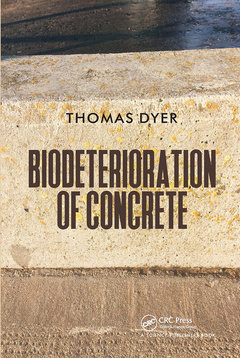Biodeterioration of Concrete
Auteur : Dyer Thomas

Awareness of the importance of ensuring durability of concrete has been a growing concern of engineers, and there is now considerable understanding of the mechanisms, which cause its deterioration, and means of limiting such damage through the use of appropriate materials and approaches to design.
Many of the deterioration mechanisms, which affect concrete, are the result of interaction with the non-living environment ? chlorides in seawater, carbon dioxide in the atmosphere, cyclic freezing and thawing. However, living organisms can also cause damage ? through both chemical and physical processes - which under the right conditions, can be severe.
This book looks at all forms of concrete biodeterioration together for the first time. It examines, from a fundamental starting point, biodeterioration mechanisms, as well as the conditions which allow living organisms (bacteria, fungi, plants and a range of marine organisms) to colonise concrete. A detailed evaluation of chemical compounds produced by living organisms with respect to their interaction with the mineral constituents of concrete, and the implications it has for the integrity of structures, is also included. Approaches to avoiding biodeterioration of concrete are also covered, including selection of materials, mix proportioning, design, and use of protective systems.
Introduction. The Chemistry of Concrete Biodeterioration. Bacterial Biodeterioration. Fungal Biodeterioration. Plants and Biodeterioration. Damage to Concrete from Animal Activity.
Thomas Dyer, Ph.D, is a lecturer in the Division of Civil Engineering at the University of Dundee, Scotland.
Date de parution : 03-2021
15.6x23.4 cm
Date de parution : 05-2017
15.6x23.4 cm
Thèmes de Biodeterioration of Concrete :
Mots-clés :
Acid Attack; Purple Sea Urchin; marine; Calcium Aluminate Cement; worm; Thiobacillus Thiooxidans; bird; Portland Cement; droppings; Concrete Surface; structures; Vascular Plants; calcareous; Solubility Diagram; aggregate; Sulphur Oxidising Bacteria; boring; Nitrifying Bacteria; sponges; Sulphuric Acid Attack; balanus; Cement Paste; Sf; Calcium Oxalate; Calcareous Aggregate; Nitric Acid Attack; Stability Constants; Cement Paste Specimens; PC Paste; Aspergillus Niger; Bird Droppings; Cement Ratio; Sulphuric Acid Solution; Boring Sponges; Acid Dissociation Constant



